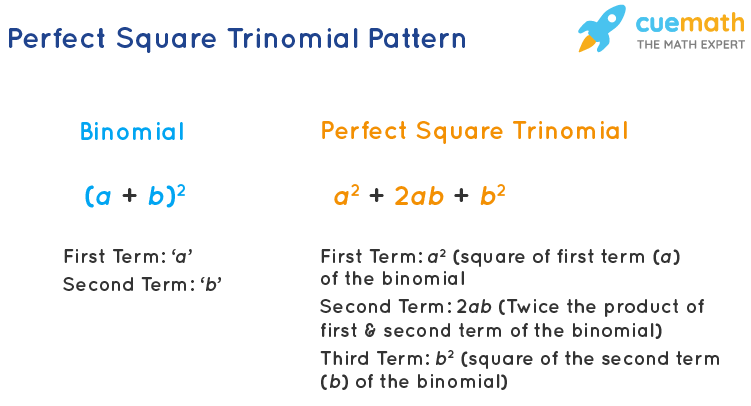Introduction
Algebra is filled with patterns and formulas that simplify complex mathematical problems. Among these, the perfect square trinomial stands out as one of the most important. This concept not only helps in simplifying polynomials but also plays a crucial role in factoring, solving quadratic equations, and understanding higher-level mathematics.
In this article, we will explore the definition, properties, examples, applications, and step-by-step methods for identifying and working with perfect square trinomials. By the end, you will have a deep understanding of why they are essential in algebra and beyond.
What is a Perfect Square Trinomial?
A perfect square trinomial is a special type of polynomial with three terms that can be expressed as the square of a binomial.
Mathematically, it can be written as: (a+b)2=a2+2ab+b2(a + b)^2 = a^2 + 2ab + b^2(a+b)2=a2+2ab+b2
or (a−b)2=a2−2ab+b2(a – b)^2 = a^2 – 2ab + b^2(a−b)2=a2−2ab+b2
This means a trinomial is a perfect square if it fits either of these patterns.
General Form:
- Positive form: x2+2xy+y2x^2 + 2xy + y^2×2+2xy+y2
- Negative form: x2−2xy+y2x^2 – 2xy + y^2×2−2xy+y2
Identifying a Perfect Square Trinomial
Not every trinomial is a perfect square. To check, you must verify three conditions:
- First and last terms are perfect squares.
Example: x2x^2×2 and 999 are perfect squares. - Middle term is twice the product of the square roots of the first and last terms.
Example: In x2+6x+9x^2 + 6x + 9×2+6x+9, the middle term 6x6x6x equals 2(x)(3)2(x)(3)2(x)(3). - Signs match correctly.
If it’s (a+b)2(a + b)^2(a+b)2, the middle term is positive; if (a−b)2(a – b)^2(a−b)2, the middle term is negative.

Examples of Perfect Square Trinomials
Example 1:
x2+10x+25x^2 + 10x + 25×2+10x+25
- First term: x2x^2×2 (perfect square).
- Last term: 25=5225 = 5^225=52.
- Middle term: 10x=2(x)(5)10x = 2(x)(5)10x=2(x)(5).
✅ Perfect square trinomial = (x+5)2(x + 5)^2(x+5)2.
Example 2:
4y2−12y+94y^2 – 12y + 94y2−12y+9
- First term: 4y2=(2y)24y^2 = (2y)^24y2=(2y)2.
- Last term: 9=329 = 3^29=32.
- Middle term: −12y=2(2y)(−3)-12y = 2(2y)(-3)−12y=2(2y)(−3).
✅ Perfect square trinomial = (2y−3)2(2y – 3)^2(2y−3)2.
Example 3 (Not a perfect square):
x2+8x+15x^2 + 8x + 15×2+8x+15
- First term: x2x^2×2.
- Last term: 151515 (not a perfect square).
❌ Not a perfect square trinomial.
Factoring Perfect Square Trinomials
Factoring is the process of expressing a trinomial as a product of its binomial square.
Step-by-Step Method:
- Check if the first and last terms are perfect squares.
- Verify the middle term equals twice the product of their square roots.
- Write the trinomial as the square of a binomial.
Example:
Factor x2+14x+49x^2 + 14x + 49×2+14x+49.
- x2=(x)2x^2 = (x)^2×2=(x)2
- 49=(7)249 = (7)^249=(7)2
- 14x=2(x)(7)14x = 2(x)(7)14x=2(x)(7)
Therefore:
x2+14x+49=(x+7)2x^2 + 14x + 49 = (x + 7)^2×2+14x+49=(x+7)2

Expanding Perfect Square Trinomials
Expanding means rewriting the binomial square as a trinomial.
Example:
Expand (x−6)2(x – 6)^2(x−6)2. (x−6)(x−6)=x2−6x−6x+36=x2−12x+36(x – 6)(x – 6) = x^2 – 6x – 6x + 36 = x^2 – 12x + 36(x−6)(x−6)=x2−6x−6x+36=x2−12x+36
So, (x−6)2=x2−12x+36(x – 6)^2 = x^2 – 12x + 36(x−6)2=x2−12x+36.
Must Read=Blooket Join: The Ultimate Guide for Students and Teachers
Applications of Perfect Square Trinomials
1. Quadratic Equations
Perfect square trinomials often appear in quadratic equations. Recognizing them allows faster solving.
Example: x2+8x+16=0x^2 + 8x + 16 = 0x2+8x+16=0 (x+4)2=0 ⟹ x=−4(x + 4)^2 = 0 \implies x = -4(x+4)2=0⟹x=−4
2. Completing the Square
This method transforms any quadratic into a perfect square trinomial.
Example: x2+6x+5x^2 + 6x + 5×2+6x+5
Take half of coefficient of xxx: 62=3\frac{6}{2} = 326=3.
Square it: 999.
Add and subtract 9: x2+6x+9−9+5=(x+3)2−4x^2 + 6x + 9 – 9 + 5 = (x + 3)^2 – 4×2+6x+9−9+5=(x+3)2−4
3. Geometry
Perfect square trinomials represent areas of squares with side lengths composed of binomials.
Example: Area of a square with side (x+5)(x + 5)(x+5) is (x+5)2=x2+10x+25(x + 5)^2 = x^2 + 10x + 25(x+5)2=x2+10x+25.
4. Algebraic Simplifications
They help simplify polynomial expressions and make calculations easier.
Common Mistakes to Avoid
- Assuming all trinomials are perfect squares.
Example: x2+5x+6x^2 + 5x + 6×2+5x+6 is factorable but not a perfect square. - Forgetting the sign of the middle term.
Example: x2−10x+25x^2 – 10x + 25×2−10x+25 is (x−5)2(x – 5)^2(x−5)2, not (x+5)2(x + 5)^2(x+5)2. - Ignoring coefficients other than 1.
Example: 9×2+12x+49x^2 + 12x + 49×2+12x+4 → Must recognize (3x+2)2(3x + 2)^2(3x+2)2.
Practice Problems
Identify if the following are perfect square trinomials:
- x2+16x+64x^2 + 16x + 64×2+16x+64
- 4y2−20y+254y^2 – 20y + 254y2−20y+25
- x2+9x+20x^2 + 9x + 20×2+9x+20
- 25a2+30a+925a^2 + 30a + 925a2+30a+9
- m2−14m+49m^2 – 14m + 49m2−14m+49
Answers:
- Yes → (x+8)2(x + 8)^2(x+8)2
- Yes → (2y−5)2(2y – 5)^2(2y−5)2
- No
- No
- Yes → (m−7)2(m – 7)^2(m−7)2
Importance in Mathematics
Perfect square trinomials serve as building blocks for advanced math concepts, including:
- Polynomial factorization
- Solving quadratic equations
- Calculus (derivatives of squared functions)
- Algebraic identities
- Mathematical modeling in physics and engineering
They simplify processes, reduce errors, and provide shortcuts for solving problems efficiently.
Conclusion
The perfect square trinomial is more than just an algebraic identity; it is a cornerstone of polynomial mathematics. By understanding its structure—where the first and last terms are perfect squares and the middle term is twice their product—you can quickly recognize, factor, and expand such expressions.
This knowledge is valuable not only in algebra but also in real-world applications like geometry, physics, and engineering. With practice, spotting perfect square trinomials becomes second nature, making algebra much easier and more enjoyable.


